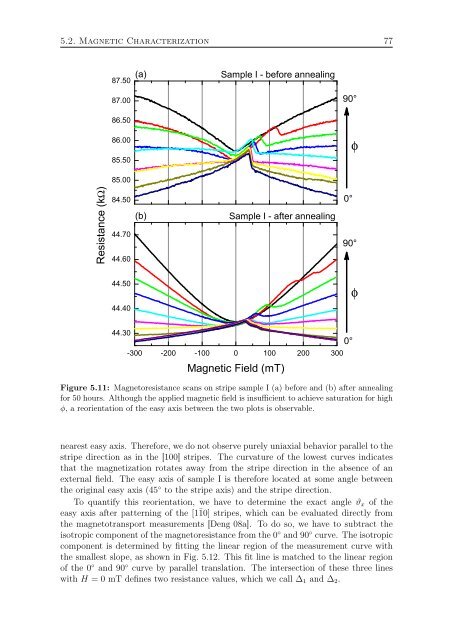Ferromagnetic (Ga,Mn)As Layers and ... - OPUS Würzburg
Ferromagnetic (Ga,Mn)As Layers and ... - OPUS Würzburg
Ferromagnetic (Ga,Mn)As Layers and ... - OPUS Würzburg
Create successful ePaper yourself
Turn your PDF publications into a flip-book with our unique Google optimized e-Paper software.
5.2. Magnetic Characterization 77<br />
8 7 .5 0<br />
<br />
<br />
<br />
8 7 .0 0<br />
<br />
8 6 .5 0<br />
8 6 .0 0<br />
8 5 .5 0<br />
φ<br />
8 5 .0 0<br />
Ω<br />
8 4 .5 0<br />
4 4 .7 0<br />
4 4 .6 0<br />
<br />
<br />
<br />
<br />
<br />
4 4 .5 0<br />
φ<br />
4 4 .4 0<br />
4 4 .3 0<br />
-3 0 0 -2 0 0 -1 0 0 0 1 0 0 2 0 0 3 0 0<br />
<br />
Figure 5.11: Magnetoresistance scans on stripe sample I (a) before <strong>and</strong> (b) after annealing<br />
for 50 hours. Although the applied magnetic field is insufficient to achieve saturation for high<br />
φ, a reorientation of the easy axis between the two plots is observable.<br />
<br />
nearest easy axis. Therefore, we do not observe purely uniaxial behavior parallel to the<br />
stripe direction as in the [100] stripes. The curvature of the lowest curves indicates<br />
that the magnetization rotates away from the stripe direction in the absence of an<br />
external field. The easy axis of sample I is therefore located at some angle between<br />
the original easy axis (45 ◦ to the stripe axis) <strong>and</strong> the stripe direction.<br />
To quantify this reorientation, we have to determine the exact angle ϑ x of the<br />
easy axis after patterning of the [1¯10] stripes, which can be evaluated directly from<br />
the magnetotransport measurements [Deng 08a]. To do so, we have to subtract the<br />
isotropic component of the magnetoresistance from the 0 ◦ <strong>and</strong> 90 ◦ curve. The isotropic<br />
component is determined by fitting the linear region of the measurement curve with<br />
the smallest slope, as shown in Fig. 5.12. This fit line is matched to the linear region<br />
of the 0 ◦ <strong>and</strong> 90 ◦ curve by parallel translation. The intersection of these three lines<br />
with H = 0 mT defines two resistance values, which we call ∆ 1 <strong>and</strong> ∆ 2 .
















